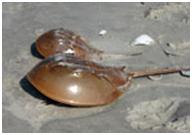I had the pleasure of visiting Little St. Simon’s Island again this year. A barrier island off the Georgia coast, even with a small lodge, it remains a wild place and offers great birding. Right now it is a wonderful place to hone shorebird identification skills. I find shorebirds daunting to identify and so I try to focus on a learning a few more each time I visit a shorebird haven. LSSI is one of those havens with big wild and windy beaches and this time of year it is full of shorebirds. There were black bellied plovers, sanderlings, 3 endangered piping plovers, many marbled godwits, dunlins, dowitchers, killdeer, Caspian and royal terns to name a few. A single curlew stood out head and shoulders above the crowd. There were also hundreds of red knots. This gives slight hope that these birds may have a fighting chance.
The migration of the red knot is arduous – some fly over 9000 miles in one direction – breaking the migration into 1500 mile segments. Relying on arrival at the Delaware Bay beaches just as the horseshoe crab population begins releasing eggs, these birds, exhausted from their long migration gorge on these  eggs and it is essential to their continued survival as they need to double their depleted weight in just a couple of days to continue on their way. But, horseshoe crabs are also cheap bait and in recent years have been “harvested” in such enormous quantities that their populations are crashing. This is not good for the primitive horseshoe crab, which has managed to live in abundance for 350 million years, and it also spells destruction for the red knot. Recently, several key states where horseshoe crabs are “harvested” have instituted a moratorium on these harvests. New Jersey has kept this moratorium in place, but the courts in Delaware rejected it, bowing to the interests of the Delaware Bay fishermen who wanted to use these crabs for bait.
eggs and it is essential to their continued survival as they need to double their depleted weight in just a couple of days to continue on their way. But, horseshoe crabs are also cheap bait and in recent years have been “harvested” in such enormous quantities that their populations are crashing. This is not good for the primitive horseshoe crab, which has managed to live in abundance for 350 million years, and it also spells destruction for the red knot. Recently, several key states where horseshoe crabs are “harvested” have instituted a moratorium on these harvests. New Jersey has kept this moratorium in place, but the courts in Delaware rejected it, bowing to the interests of the Delaware Bay fishermen who wanted to use these crabs for bait.
The Red knot’s decline has been precipitous – from 100,000 20 years ago to around 13,000 in recent years. In a story that seems almost too impossible to be true, an entire species of bird and a prehistoric marine creature, whose very lives are tied together, may both become extinct because there was insufficient interest in finding alternate types of bait for fishermen in the Delaware Bay.
You can help by sending an email or letter to the Governor of Delaware asking him to please reinstitute the moratorium on horseshoe crab “harvests”.